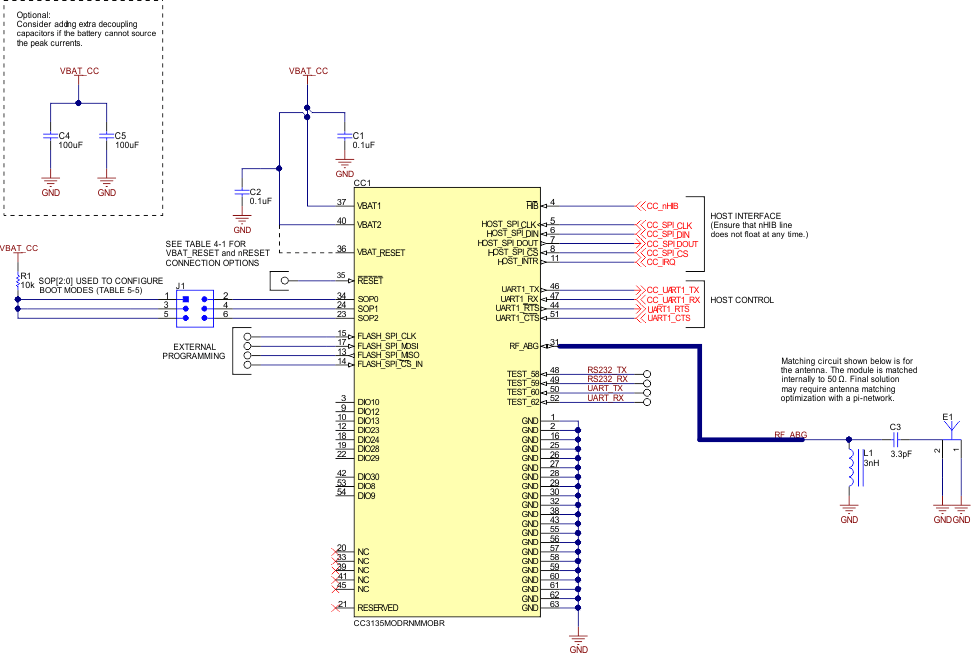JAJSHT5D February 2019 – May 2021 CC3135MOD
PRODUCTION DATA
- 1 特長
- 2 アプリケーション
- 3 概要
- 4 機能ブロック図
- 5 Revision History
- 6 Device Comparison
- 7 Terminal Configuration and Functions
-
8 Specifications
- 8.1 Absolute Maximum Ratings
- 8.2 ESD Ratings
- 8.3 Recommended Operating Conditions
- 8.4 Current Consumption Summary: 2.4 GHz RF Band
- 8.5 Current Consumption Summary: 5 GHz RF Band
- 8.6 TX Power Control for 2.4 GHz Band
- 8.7 TX Power Control for 5 GHz Band
- 8.8 Brownout and Blackout Conditions
- 8.9 Electrical Characteristics for DIO Pins
- 8.10 WLAN Receiver Characteristics
- 8.11 WLAN Transmitter Characteristics
- 8.12 BLE and WLAN Coexistence Requirements
- 8.13 Reset Requirement
- 8.14 Thermal Resistance Characteristics for MOB Package
- 8.15 Timing and Switching Characteristics
- 8.16 External Interfaces
- 9 Detailed Description
- 10Applications, Implementation, and Layout
- 11Environmental Requirements and SMT Specifications
- 12Device and Documentation Support
- 13Mechanical, Packaging, and Orderable Information
10.1.3 Typical Application
Figure 10-3 shows the typical application schematic using the CC3135MOD module.

This is the reference schematic and not an actual board design. For a full operational reference design, see the CC3135MOD Hardware Design Files.
Figure 10-3 CC3135MOD Module Reference SchematicNote:
The following guidelines are recommended for implementation of the RF design:
- Ensure an RF path is designed with an impedance of 50 Ω
- Tuning of the antenna impedance π matching network is recommended after manufacturing of the PCB to account for PCB parasitics
- π or L matching and tuning may be required between cascaded passive components on the RF path
Table 10-1 lists the bill of materials for a typical application using the CC3135MOD module shown in Figure 10-3.
Table 10-1 Bill of Materials
| QTY | PART REFERENCE | VALUE | MANUFACTURER | PART NUMBER | DESCRIPTION |
|---|---|---|---|---|---|
| 2 | C1, C2 | 0.1 uF | Murata | GRM155R61A104KA01D | Capacitor, ceramic, 0.1 uF, 10 V, ±10%, X5R, 0402 |
| 1 | C3 | 3.3 pF | Murata | GJM1555C1H3R3BB01 | Capacitor, ceramic, 3.3 pF, 50 V, ±0.1pF, C0G/NP0, 0402 |
| 2 | C4, C5 | 100 uF | Murata | LMK325ABJ107MMHT | Capacitor, ceramic, 100 uF, 10 V, ±20%, X5R, AEC-Q200 Grade 3, 1210 |
| 1 | E1 | 2.4 GHz, 5 GHz Ant | Ethertronics | M830520 | Antenna Bluetooth WLAN Zigbee® |
| 1 | L1 | 3 nH | Murata | LQG15HS3N0S02D | Inductor, Unshielded, Multilayer, 3nH, 0.8 A, 0.125 Ω, SMD |
| 1 | R1 | 10k | Vishay-Dale | CRCW040210K0JNED | RES, 10 k, 5%, 0.063 W, AEC-Q200 Grade 0, 0402 |
| 1 | CC1 | CC3135MOD | Texas Instruments | CC3135MODRNMMOBR | SimpleLink™ Certified Wi-Fi® Dual-Band Network Processor Internet-of-Things Module Solution for MCU Applications, MOB0063A |